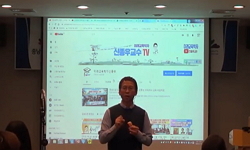This article examines the development of pansori from the 18th century to the 20th century, focusing on the Chungcheongnam-do region. In particular, the discussion centered on the formative period of Pansori in the 18th century. It was noted that the ...
http://chineseinput.net/에서 pinyin(병음)방식으로 중국어를 변환할 수 있습니다.
변환된 중국어를 복사하여 사용하시면 됩니다.
- 中文 을 입력하시려면 zhongwen을 입력하시고 space를누르시면됩니다.
- 北京 을 입력하시려면 beijing을 입력하시고 space를 누르시면 됩니다.

18~20세기 충남지역 판소리의 전개 = Development of Pansori in Chungcheongnam-do in the 18th and 20th centuries
한글로보기https://www.riss.kr/link?id=A108907833
-
저자
최혜진 (목원대학교)
- 발행기관
- 학술지명
- 권호사항
-
발행연도
2023
-
작성언어
Korean
-
주제어
판소리 ; 충남 ; 최선달 ; 유진한 ; 신광수 ; 중고제 ; 음악문화 ; Pansori ; South Chungnam Province ; Choi Seon-dal ; Yu Jin-han ; Shin Gwang-soo ; Joonggoje ; music culture
-
등재정보
KCI등재
-
자료형태
학술저널
- 발행기관 URL
-
수록면
67-86(20쪽)
- DOI식별코드
- 제공처
-
0
상세조회 -
0
다운로드
부가정보
다국어 초록 (Multilingual Abstract)
In the 19th century, Kim Seong-ok, the founder of Joonggoje, as well as Yeom Gye-dal, Mo Heung-gap, and Song Heung-rok, were active in the Chungcheong region of Gyeonggi Province, and many master singers continued the Goje tradition by developing singing methods and rhythms. The sound of this period is called Joonggoje, and Joonggoje continued its tradition until the mid-20th century. In the early 20th century, Shim Jeong-sun, Lee Dong-baek, and Kim Chang-ryong, who were active as modern singers, led the Changgeuk movement as well as pansori, but the center of transmission changed to Dongpyeonje and Seopyeonje songs. However, in the 20th century, in Pansori families in the Chungcheongnam-do region, song and dance, such as dance and performance, were passed down together, and the concept of Joonggoje is expanding to the scope of song and dance.
This article examines the development of pansori from the 18th century to the 20th century, focusing on the Chungcheongnam-do region. In particular, the discussion centered on the formative period of Pansori in the 18th century. It was noted that the 18th century was a time when Choi Seon-dal, who was designated as the first master singer, Yu Jin-han, who wrote the first <Chunhyang-ga>, and Shin Gwang-soo, who has a record with the clown Won Chang, were active. Yu Jin-han and Shin Gwang-su were famous as writers in Cheonan and Seocheon, respectively, and were figures who led the culture of their time by participating in poetry associations together. In addition, they were part of the Namin faction and realized musical Silhak(實學) by creating a new musical culture and culture before Silhak ideology came to the surface in earnest. By reinterpreting the records of the time, errors were corrected and the influence they had on pansori culture, especially in the Chungcheongnam-do region, was identified. The pansori they created and sang is called Goje.
In the 19th century, Kim Seong-ok, the founder of Joonggoje, as well as Yeom Gye-dal, Mo Heung-gap, and Song Heung-rok, were active in the Chungcheong region of Gyeonggi Province, and many master singers continued the Goje tradition by developing singing methods and rhythms. The sound of this period is called Joonggoje, and Joonggoje continued its tradition until the mid-20th century. In the early 20th century, Shim Jeong-sun, Lee Dong-baek, and Kim Chang-ryong, who were active as modern singers, led the Changgeuk movement as well as pansori, but the center of transmission changed to Dongpyeonje and Seopyeonje songs. However, in the 20th century, in Pansori families in the Chungcheongnam-do region, song and dance, such as dance and performance, were passed down together, and the concept of Joonggoje is expanding to the scope of song and dance.
참고문헌 (Reference)
1 이보형, "한국전통음악논구" 고려대학교 민족문화연구소 1990
2 김동욱, "한국가요의 연구" 을유문화사 1961
3 최혜진, "판소리의 탄생과 중고제" 문화in 2020
4 서대석, "판소리의 전승론적 연구-서사무가와의 대비에서" 한국인문사회과학회 3 (3): 122-142, 1979
5 배연형, "판소리의 고제・중고제・신제" 판소리학회 (55) : 103-160, 2023
6 김종철, "판소리사 연구" 역사비평사 1996
7 박황, "판소리 이백년사" 사사연 2001
8 최혜진, "판소리 명창의 비조 최선달 연구" 판소리학회 (45) : 373-401, 2018
9 서대석, "판소리 기원론의 재검토" 한국고전문학회 16 : 35-58, 1999
10 신은주, "충청지역 판소리 문화의 역사와 전승양상" 한국음악사학회 (40) : 367-410, 2008
1 이보형, "한국전통음악논구" 고려대학교 민족문화연구소 1990
2 김동욱, "한국가요의 연구" 을유문화사 1961
3 최혜진, "판소리의 탄생과 중고제" 문화in 2020
4 서대석, "판소리의 전승론적 연구-서사무가와의 대비에서" 한국인문사회과학회 3 (3): 122-142, 1979
5 배연형, "판소리의 고제・중고제・신제" 판소리학회 (55) : 103-160, 2023
6 김종철, "판소리사 연구" 역사비평사 1996
7 박황, "판소리 이백년사" 사사연 2001
8 최혜진, "판소리 명창의 비조 최선달 연구" 판소리학회 (45) : 373-401, 2018
9 서대석, "판소리 기원론의 재검토" 한국고전문학회 16 : 35-58, 1999
10 신은주, "충청지역 판소리 문화의 역사와 전승양상" 한국음악사학회 (40) : 367-410, 2008
11 권선정, "충남학의 이해" 충청남도 2014
12 김동욱, "증보 <춘향전> 연구" 연세대출판부 1976
13 최혜진, "중고제(中古制) 김성옥 명창과 강경의 지역적 위상" 판소리학회 (53) : 445-486, 2022
14 손태도, "조선시대의 ‘광대’와 ‘판소리’에 대한 몇 가지 논의들" 판소리학회 (36) : 211-266, 2013
15 심재덕, "조선소리 내력기"
16 신웅순, "신광수의 ‘관산융마’"
17 신광수, "석북시집 자하시집" 명문당 2002
18 전지영, "무형유산의 지역적 특성 문제-충남지역 전승음악 중심-" 한국음악사학회 (64) : 269-292, 2020
19 유진한, "국역 만화집" 학자원 2013
20 김준기, "국역 대록지(大麓誌)" 아우내문화원 2000
21 조재삼, "교감국역 松南雜識" 한국학술진흥재단 2008
22 신광수, "관서악부" 아카넷 2018
23 김종철, "게우사" 판소리학회 5 : 212-253, 1994
24 성기련, "18세기 판소리 음악문화 연구" 한국국악학회 34 : 165-182, 2003
동일학술지(권/호) 다른 논문
-
포스트소셜 시대에 지역학으로서 음악학은 아직 유효한가?
- 한국국악학회
- 전지영
- 2023
- KCI등재
-
여주 집단 민속놀이의 복원 배경과 지역적 향유 양상 -흔암리 쌍용거줄다리기를 중심으로-
- 한국국악학회
- 노복순
- 2023
- KCI등재
-
- 한국국악학회
- 이성초
- 2023
- KCI등재
-
이말량ㆍ허순구를 중심으로 한 영남지역 풍류의 전승 양상
- 한국국악학회
- 강혜진
- 2023
- KCI등재




 eArticle
eArticle






